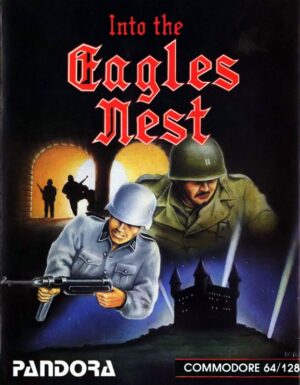Retro Replay Review
Gameplay
Actionauts offers a unique blend of puzzle-solving and basic programming mechanics that immediately sets it apart from other titles of its era. On the Commodore 64 version, you lay out commands directly on a customizable grid, using the joystick to sequence movements, turns, and special actions. This hands-on approach lets you experiment with different paths in real time, watching your robot respond to each instruction. The ability to alter the grid adds a layer of strategic depth, encouraging players to anticipate obstacles and plan several moves ahead.
(HEY YOU!! We hope you enjoy! We try not to run ads. So basically, this is a very expensive hobby running this site. Please consider joining us for updates, forums, and more. Network w/ us to make some cash or friends while retro gaming, and you can win some free retro games for posting. Okay, carry on 👍)
In contrast, the Atari 2600 iteration streamlines the experience by offering preset mazes and a separate programming screen. Here, you select from a menu of commands and slot them into your robot’s memory, then hit “Run” to see if it reaches the cheese reward. This two-screen setup introduces a subtle tension: once you leave the programming interface, there’s no mid-run tweaking. You must replay the sequence from the start if you make a mistake, adding a satisfying challenge for those who love trial-and-error gameplay.
Both versions let you choose between multiple robot designs, but the Commodore 64 release particularly stands out by letting you pick from four distinct models, each with its own color palette and personality. This small customization perk delivers extra motivation to tackle higher-difficulty levels. Overall, the gameplay loop in Actionauts is highly engaging—a blend of logical thinking, pattern recognition, and nimble execution that will keep puzzle fans hooked for hours.
One potential drawback is the learning curve for players unfamiliar with programming concepts. While simple forward, turn-left, and turn-right commands are intuitive, building long command chains can feel daunting at first. However, the built-in tutorial grid on the C64 version and the Atari 2600’s straightforward command icons help bridge that gap. In the end, mastering your robot’s movement becomes a rewarding puzzle-solving exercise that balances patience with creativity.
Graphics
Given the hardware limitations of both the Commodore 64 and the Atari 2600, Actionauts does an admirable job of presenting clear, functional visuals. On the C64, the grid is crisp and color-coded, making it easy to differentiate between pathways, obstacles, and command panels. The robot sprites are simple but charming, with each of the four selectable models sporting unique colors and a subtle animation when executing commands. The interface remains uncluttered, letting you focus on the puzzle at hand.
The Atari 2600 version takes a more minimalist approach. Mazes are rendered in solid blocks of color, and the robot icon is reduced to a single, blinking sprite. While this may feel basic compared to modern standards, the clear contrast between walls, open spaces, and the cheese goal ensures you never lose track of your objective. The second-screen programming interface uses chunky command icons that are easily distinguishable, even on older CRT televisions.
In both versions, animations are kept to a minimum, but that actually enhances the experience by putting the puzzle front and center. There’s no distracting particle effects or unnecessary cutscenes—just straightforward visual feedback when your robot moves, bumps into a wall, or reaches the cheese. This simplicity contributes to the game’s charm, making it an attractive pick for retro enthusiasts who value clarity over flashiness.
Although graphics may not win any awards by today’s standards, they remain entirely fit for purpose. The designers prioritized player comprehension, ensuring every visual element serves the gameplay. For those looking to introduce programming concepts in a visually digestible way, Actionauts strikes a perfect balance between form and function on both classic platforms.
Story
Actionauts doesn’t boast a sprawling narrative or cinematic cutscenes—instead, it embraces a minimalist story framework centered on robotic exploration and the pursuit of cheese. This straightforward premise might sound whimsical, but it provides just enough context to make each level feel purposeful. You’re not merely solving abstract puzzles; you’re directing a mechanical envoy through perilous mazes to retrieve a coveted dairy prize.
The scant backstory actually works in the game’s favor, as it keeps the focus squarely on puzzle design and programming strategy. A brief title screen blurb hints at a world of competing robot designs, suggesting a playful rivalry among “Actionaut” engineers. Beyond that, the scenarios speak for themselves: each maze is presented as a new assignment, and the satisfaction of success stems from clever command sequencing rather than elaborate plot twists.
For players seeking a deeper narrative, the simplicity may feel underwhelming. However, the lighthearted tone and just-enough premise cultivate a quirky charm that aligns perfectly with the game’s arcade-meets-logic identity. The “cheese reward” concept injects a dash of humor and motivation, making each failed attempt less of a frustration and more of a comedic hiccup on your path to mastery.
While Actionauts could have embellished its world with more lore or varying objectives, its pared-down story effectively supports the gameplay. In a sense, the lack of heavy narrative liberates you to become the protagonist programmer—crafting your own path through each maze and writing your own “robot success story” one command at a time.
Overall Experience
Actionauts shines as a pioneering title for gamers intrigued by early programming concepts and puzzle-solving. Its blend of command sequencing, platform-specific variations, and lighthearted premise makes for an engaging package that holds up surprisingly well decades after its release. Whether you’re customizing grid layouts on the Commodore 64 or tackling preset mazes on the Atari 2600, each session tests your logic skills while delivering a steady stream of “aha!” moments.
The learning curve is gentle enough for newcomers yet deep enough to satisfy seasoned puzzle veterans. The ability to experiment freely on the C64 adds replay value, while the stricter, higher-stakes environment on the Atari 2600 appeals to perfectionists who love iterative problem-solving. Both versions demonstrate thoughtful design that respects the strengths and constraints of their respective platforms.
Visually, Actionauts leverages simplicity to its advantage, providing clear, concise feedback that reinforces the programming loop. The minimalist story framework—centered on cheese-seeking robots—offers just enough personality to keep you invested without overshadowing the core mechanics. As an early example of “edutainment,” it strikes an admirable balance between teaching and entertaining.
Ultimately, Actionauts stands as a testament to creative design within tight technical parameters. Its enduring appeal lies in the thrill of crafting precise command sequences, the delight of watching your robot navigate devious mazes, and the infectious charm of its cheesiest of goals. For retro gaming enthusiasts, puzzle aficionados, and anyone curious about the roots of programming-based gameplay, Actionauts remains a rewarding adventure well worth your time.
 Retro Replay Retro Replay gaming reviews, news, emulation, geek stuff and more!
Retro Replay Retro Replay gaming reviews, news, emulation, geek stuff and more!









Reviews
There are no reviews yet.